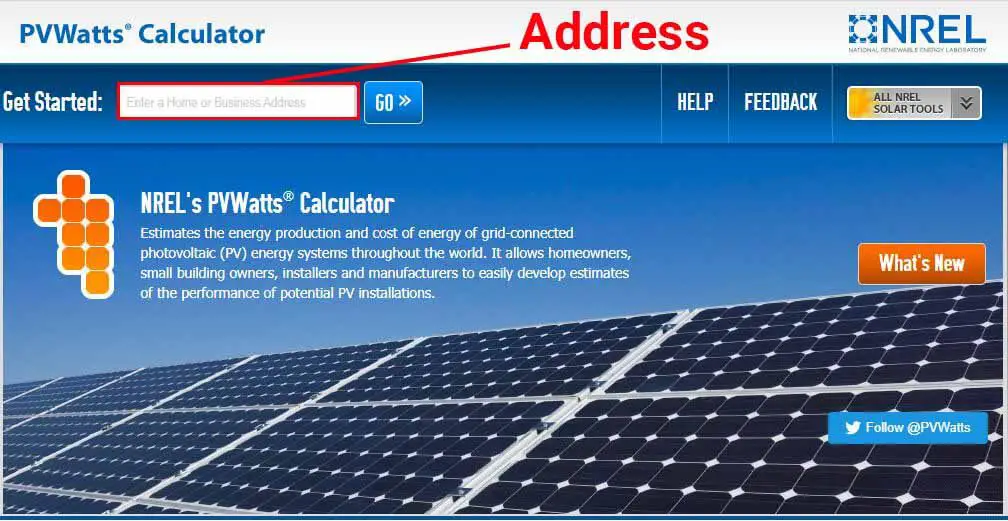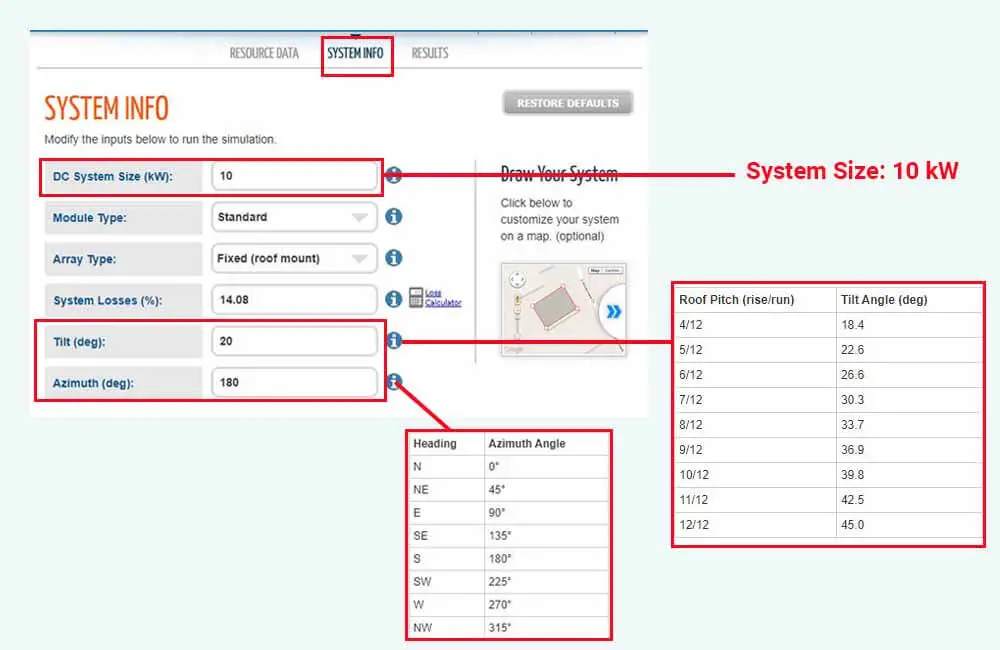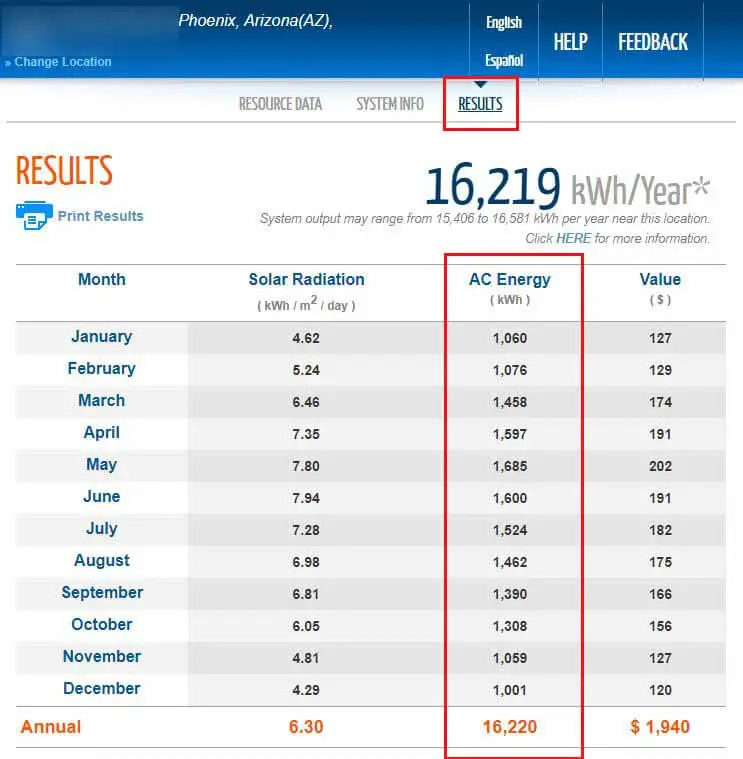With the right weather and enough sunlight, at a given moment, a 10kW solar system is capable of producing 10 kilowatts, which is a substantial amount of power. However, what you pay for at the end of the month, and what really matters, is not Power (kW), but your energy consumption/production (kWh).
While the power rating of a solar system (10kW in this case) describes the rate at which the solar system can potentially generate energy, what matters most is how much energy does this system produce at the end of the day.
Therefore, the question that should be asked is not “how much power does a 10kW solar system produce?”, but rather “how much energy does a 10kW solar system produce?”.
The answer to this question is not universal and depends on many factors, but generally, it depends on your location.
In this article, I will show you how to determine the amount of energy that a 10kW solar system is expected to produce in your location. After that, I will answer a couple of questions related to the topic.
How much energy does a 10kW solar system produce?
The amount of energy that a solar system produces, does not only depend on its power rating (kW) but on the amount of sunlight that it receives.
However, as a rule of thumb, a 10kW solar system would – on average – generate 40 to 55 kWh (kiloWatt-hours) of energy per day. This translates to between 1200 and 1700 kWh of monthly energy production.
This daily (and monthly) energy production will fluctuate depending on things like weather conditions and seasons. However, the average daily and monthly energy production of a 10 kW solar system can be determined, and will mainly depend on your location.
To best and easiest way to get an estimate, is to use the PVWatts Calculator by The National Renewable Energy Laboratory (NREL). The calculator is free to use, and all you need is an address:

This tool uses data from geostationary satellites (provided by NSRDB) to quantify sunlight, and therefore predict the amount of energy that a solar system is expected to produce based on a few variables that describe the solar system.
Aside from your location, the main variables are:
- DC System Size (kW): This describes the power rating of your solar system (10kW in this case)
- Tilt (deg): This describes the tilt angle of the roof section you are (or will be) using for solar. Or the tilt angle which you’ve chosen for your solar panels in case it’s a ground-mounted system (open rack).
- Azimuth: This describes the direction that your solar panels are facing. For example, if the solar panels are facing south, the Azimuth is 180 degrees.
Once you’ve submitted your address, go to the System Info section of the calculator, and make sure to submit the correct details:

In the DC System Size (kW) field, make sure to submit 10.
In the Tilt (deg) field, submit the tilt angle of the solar panels. If it’s a roof mount and you know the roof pitch of the roof section used for the solar panels, you can click the information “i” icon to see the equivalent of the roof pitch in degrees. For example, a 5/12 roof pitch is equivalent to a 22.6 tilt angle.
If it’s an open rack system or you just don’t know the roof pitch, you can use a smartphone app such as Measure for iOS or Bubble Level for Android to determine the tilt angle.
Next to the Azimuth (deg) field, click on the “i” icon to see the equivalent of the heading in degrees. For example, if the solar panels are facing South-West, the Azimuth is 225 degrees. If you don’t know the direction that the roof section is facing, you can use a compass app such as Commander Compass Go for iOS or Azimuth Compass for Android.
Once you’ve submitted the correct details you can go to the Results section of the calculator to see the results.
For example, I will submit the following details to the calculator and show you the results below:
- Address: an address in Phoenix, Arizona.
- DC System Size: 10kW.
- Tilt: I’ll assume the system is roof-mounted with a 6/12 roof pitch, which is equivalent to a tilt angle of 26.6 degrees.
- Azimuth: I’ll assume that the only unshaded roof section available is facing South-West, this equates to an Azimuth of 225 degrees.
In the Results tab, the calculator provided the following table:

According to the PVWatts calculator, a system of this size, description, and in this location, would produce 16220 kWh of energy per year. This amount of energy equates to about 45 kWh/day or 1350 kWh/month.
It’s also important to note that these results are based on the assumption that the overall system losses add up to 14% (86% system efficiency).
How many solar panels do you need for a 10kW solar system?
A 10kW solar system would consist of anywhere between 25 and 40 residential solar panels. The exact number of solar panels needed for a 10kW solar system will depend on the power rating (wattage) of each solar panel, which can be from 250 to 400 watts.
For example, a 10kW solar system that’s made up of 330W solar panels would consist of 30 of these solar panels.
To give you an idea of what to expect, the following table provides some of the most popular residential solar panels, their power ratings, and how many of them it would take to make up a 10kW solar system:
| Solar Panel Model | Rated Power | Number of solar panels needed for a 10 kW system |
| LG NeON® R Series | 365 – 380 Watts | 28 |
| Canadian Solar SUPERPOWER series | 290 – 305 Watts | 34 |
| FuturaSun FU-M series | 300 – 315 Watts | 34 |
| Panasonic EverVolt Series | 360 – 370 Watts | 28 |
| REC Twin Peak 4 Series | 360 – 375 Watts | 28 |
| LG NeON® 2 72cell Series | 390 Watts | 26 |
| Hyundai HiS-RI Solar Panels | 330 – 360 Watts | 30 |
| Canadian Solar MAXPOWER Series | 325 – 340 Watts | 32 |
| Canadian Solar KuMax series | 380 – 400 Watts | 26 |
| JinkoSolar’s JKM390M-72H | 390 Watts | 26 |
| REC TwinPeak 2S MONO 72 Series | 370 – 400 Watts | 26 |
How much roof space do you need for a 10kW solar system?
A 10kW solar system would require 550 to 650 ft² (51-60 m²) of space depending mainly on the efficiency of the solar panels that the system is made up of. The higher the efficiency of the solar panels, the less roof space you’ll need.
Here are the same solar panels mentioned above, their respective areas, and how much space would be required to make up a 10kW out of each of these panels:
| Solar Panel Model | Area | Roof space needed for a 12 kW system |
| LG NeON® R Series | 18.6 ft² (1.72 m²) | 520 ft² (48.3 m²) |
| Canadian Solar SUPERPOWER series | 17.6 ft² (1.63 m²) | 598 ft² (55.5 m²) |
| FuturaSun FU-M series | 17.6 ft² (1.63 m²) | 590 ft² (54.8 m²) |
| Panasonic EverVolt Series | 18.8 ft² (1.74 m²) | 526 ft² (48.8 m²) |
| REC Twin Peak 4 Series | 19.7 ft² (1.83 m²) | 551 ft² (51.2 m²) |
| LG NeON® 2 72cell Series | 22.3 ft² (2 m²) | 580 ft² (53.9 m²) |
| Hyundai HiS-RI Solar Panels | 21.1 ft² (1.96 m²) | 633 ft² (58.8 m²) |
| Canadian Solar MAXPOWER Series | 21.4 ft² (1.98 m²) | 685 ft² (63.6 m²) |
| Canadian Solar KuMax series | 21.4 ft² (1.98 m²) | 556 ft² (51.6 m²) |
| JinkoSolar’s JKM390M-72H | 21.7 ft² (2 m²) | 564 ft² (52.4 m²) |
| REC TwinPeak 2S MONO 72 Series | 21.6 ft² (2 m²) | 561 ft² (52.1 m²) |
Learn more about the different types of residential solar panels and their dimensions here: How big is a solar panel?
If you have shading issues on your roof and suspect there’s not enough usable space for the 10kW solar system, please refer to this page: How many solar panels can you fit on your roof?


